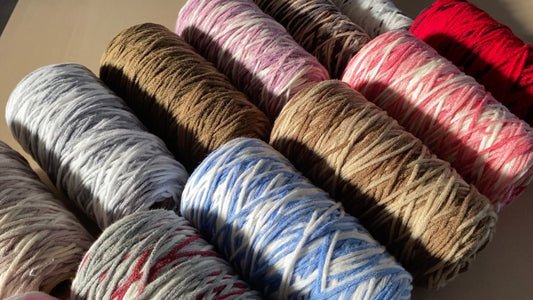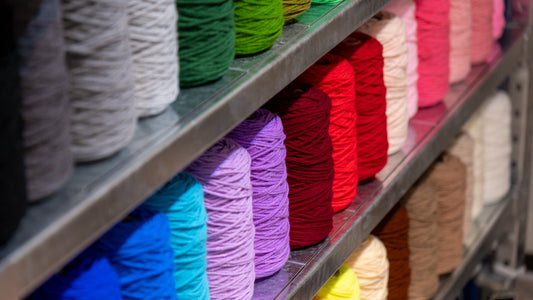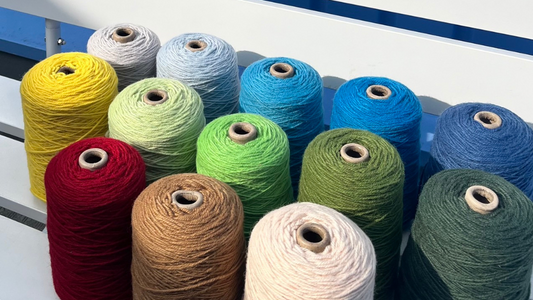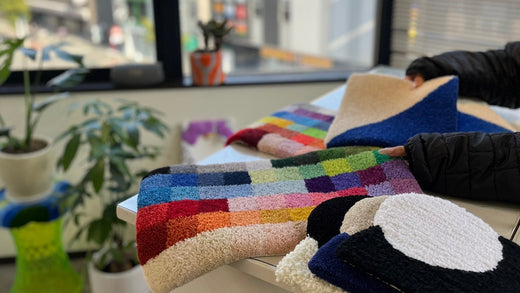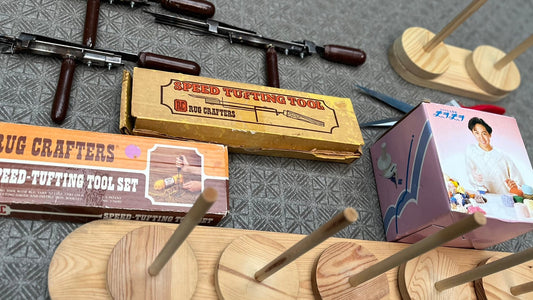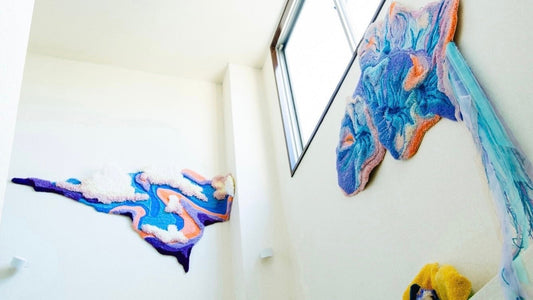
[Must-see for beginners] Creating works using the tufting gun AK-2 loop pile
Hello. We are Tufting studio & shop RUGMATAG, a tufting workshop and equipment/materials specialist store in Morinomiya, Osaka .
This time, we asked Miura, a new staff member who joined RUGMATAG three months ago, to create a piece using the AK-2 for the first time, and asked him about the difficulties he faced and things he should be careful about!
I hope this will be helpful for those who would like to try creating something using the AK-2, or for those who already own an AK-2 and are having trouble using it.
Rugs made with loop pile are resilient and durable. The fibers are densely packed, making them less likely to be crushed and more durable.
Its durability means it will last a long time even when used under heavy furniture or in high traffic areas.
About AK-2 Loop Pile

Unlike AK-1 cut pile, AK-2 loop pile does not have scissors and is driven into the surface in a loop shape.
There are no scissors included, so you will need to cut the yarn yourself when you are done.

At RUGMATAG, we work with small scissors hanging from our wrists like this.

With the AK-2, you can adjust the pile length by about 5mm yourself.
Use a screwdriver to turn the screw up to make the bristles longer, or down to make them shorter.
If you raise it all the way up, you won't be able to drive it in, so when you raise it up, make sure to leave a little slack on the upper side before fixing it.
Before you type

This time, I practiced some of the actual design before starting production.
Before you start the actual project, try out different types of yarn to see what type is best for the piece, and how far apart you should knit the yarn. There will be no gap between your image of the finished product and the actual product, making it less likely to fail.
Start of production
The AK-2 used in this example can be adjusted in length from 4mm to 9mm.

First, punch in the white part using the 9mm setting.
Miura: The AK-2 doesn't have scissors, so if you pull the gun after you finish shooting like you do with the AK-1, the yarn will come out with it.
At first, perhaps because I was used to operating the AK-1, I forgot to cut the yarn at the end of the stitching, which caused the yarn to come loose and I had to stitch it again, which wasted a lot of time.

Once you have finished painting the white parts, check the surface.
Miura: When I looked at the surface, I noticed that there was some yarn that had not yet formed into loops at the beginning of the weaving.
In order to reduce yarn loss with the AK-1, I kept the length of yarn sticking out at the needle tip as short as possible while skewing. With the AK-2, I found that I needed a length of yarn that would allow for a loop at the beginning of the stitch, so I improved by leaving about 5cm of yarn at the needle tip after that!

With the AK-2, if the length of yarn left at the tip of the needle is too short, the start of the stitch will not form a loop, so make sure to leave some slack in the length of yarn left at the tip of the needle.
With the AK-1, you can prevent loss of yarn at the beginning of the stitch by driving the needle into the needle without leaving too much yarn behind, as shown on the right side of the photo above.

The pile length is adjusted from 9mm to 4mm and the next color is applied.

Miura: It takes time to cut the yarn from the base after each line, and if there are any areas where the loops look uneven when viewed from the surface, you can make adjustments, so this time I left a little bit of yarn at the end of the line.

I checked the surface at a good timing, corrected it, and then cut off the exposed yarn from the root with rug scissors. Using this method has improved efficiency!

Once we had finished casting the entire surface, we checked it from the outside and cut out any protruding parts, and re-cast any uneven areas.
If there are no problems with the fitting, apply adhesive, attach the lining and let it dry.
Finishing

When finishing the AK-2, Since the surface does not generally require clipping, the finishing time is often shorter than with the AK-1.
When finishing, cut any yarn that is sticking out and not in a loop, or yarn that has loops but is of uneven height, near the base to make them less noticeable.
Completion and Impressions

Miura: This was my first time using the AK-2 to create a piece, and at first I wasn't used to cutting the thread after each stitch, so it took longer than I expected. By the end, I had gotten used to cutting and was able to create without any problems! The AK-2 felt smooth to type with, and was much quieter than the AK-1. The needle was thin, so it was easy to stitch in intricate designs. Unlike the AK-1, I thought the length could be easily adjusted, which would broaden the scope of my work!
summary

What did you think?
This is my first time using the AK-2, but the rug turned out beautifully!
The AK-2 can be a little difficult to get used to, but once you have, you will be able to create your ideal rug.
This time we created a rug using only the AK-2 loop pile, but we also recommend combining it with a rug that has a different surface appearance, such as the AK-1 cut pile.
If you're interested, be sure to try incorporating the AK-2 into your production!
About new information notifications
Thank you for reading to the end. RUGMATAG will continue to post various articles about tufting. We will regularly announce the latest information on Instagram, Twitter, our official LINE account, and our email newsletter (see below). If you are interested, please follow us on social media, add us as a friend on our official LINE account, and subscribe to our email newsletter.












